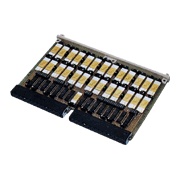The Fujitsu V Series was a series of small general-purpose computers from Fujitsu, and was positioned at the low-end of their FACOM M Series of general-purpose computers.
Fujitsu's small computers were the inexpensive FACOM 230-10 (announced in March 1965), which enabled easy use of COBOL with Japanese kana letters, and the FACOM 230-15 (announced April 1970) which enabled construction of online programs. The FACOM V0 had already been announced as the successor of the FACOM 230-10 (in August 1974), and the FACOM V was announced as the successor of the FACOM 230-15 in January 1977. This FACOM V had the following features.
- It was the first small system equipped with DB (Data Base), DE (Data Entry), DU (Data Utility) and DC (Data Communication) based on a true 4D concept.
- It achieved greater memory capacity and lower price by employing 4Kbit/chip MOS-LSI memory.
- The FACOM 230-15 employed magnetic core memory, and thus memory capacity was 32KB due to price constraints, but the FACOM V expanded capacity to a maximum of 192KB. It achieved both lower price and higher reliability.
- Speed was increased by using 500-600 gate bipolar LSI.
- Performance and functionality like that of mid-size and large machines was achieved at a low price.
The FACOM V comprised the FACOM V Series, together with the FACOM V0III (an enhanced version of the FACOM V0) and the FACOM V0SIII (an enhanced version of the FACOM V0S), which were announced at the same time. Later, the FACOM V Series of small computers was replaced with the New FACOM V Series (FACOM V-830 STREAM, V-830, V-850 and V-870), and then integrated with the FACOM K Series higher-end models announced in 1985.
| Model name | FACOM V0SIII | FACOM V0III | FACOM V | |
|---|---|---|---|---|
| Announcement date | January 1977 | |||
| Central processing unit | Number of instructions | 122 (binary fixed point and floating point, decimal fixed point, logical operations, character control etc.) | ||
| Data formats | Byte, half-word, word, double-length word (1word=32bit) | |||
| Address system | Direct, relative, base, index | |||
| Address conversion system | High-speed address conversion using TLB (Translation Lookaside Buffer) | |||
| Control system | Microprogram control | |||
| Main memory unit | Memory element | 4Kbit MOS-LSI | ||
| Cycle time | 670ns/2B | 600ns/4B | ||
| Capacity | 8-48KB | 16-64KB | 32-192KB | |
| Error check | Parity check | ECC | ||
| Memory protection mechanism | no | yes | ||
| Number of channel connections | 4 | 5 | 4 | |
| Magnetic disk unit | 10MB x 4 | 40MB x 8 | ||
| Hard disk unit | 0.5/1.0MB | 2.4MB | ||
| Floppy disk unit | 243KB (8inch, single-sided), 2drives could be built-in | |||
| Number of communication lines | 1 | 16 | ||
| Other | Equipped with FACOM 230-10 emulator capability | Equipped with FACOM 230-15 emulator capability | ||
(Note) The above specifications are from the time of announcement, and may have been changed due to later improvement.




